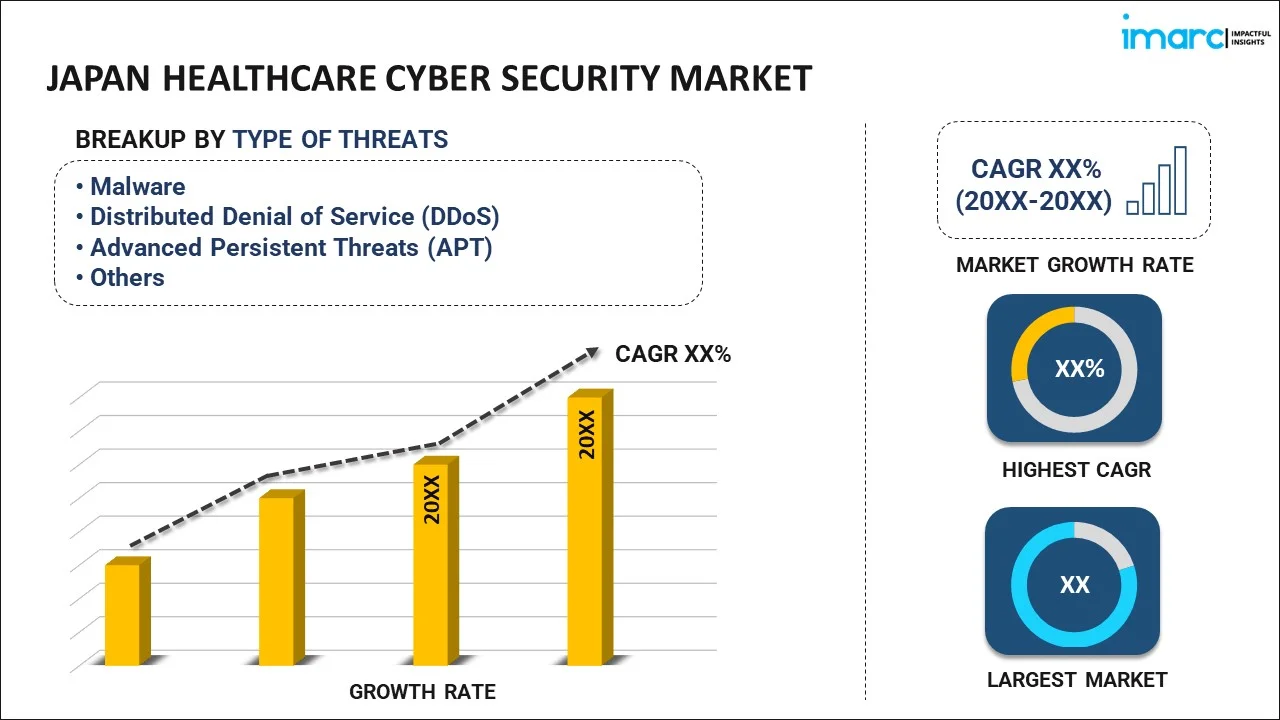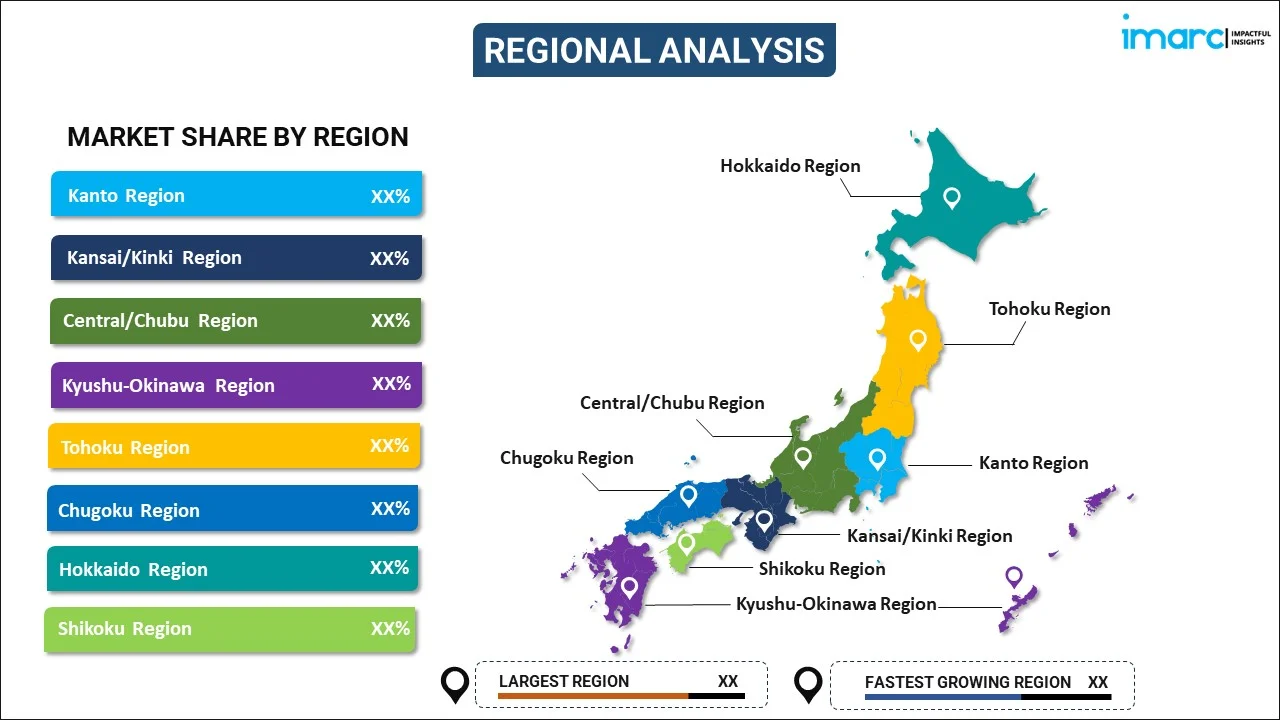
Japan Healthcare Cyber Security Market Report by Type of Threat (Malware, Distributed Denial of Service (DDoS), Advanced Persistent Threats (APT), Spyware, and Others), Type of Solution (Identity and Access Management, Risk and Compliance Management, Antivirus and Antimalware, DDoS Mitigation, Security Information and Event Management, Intrusion Detection System and Intrusion Prevention System, and Others), End User (Hospitals, Pharmaceutical Companies, Medical Device Companies, Health Insurance Companies, and Others), and Region 2025-2033
Market Overview:
Japan healthcare cyber security market size reached USD 1.3 Billion in 2024. Looking forward, IMARC Group expects the market to reach USD 5.3 Billion by 2033, exhibiting a growth rate (CAGR) of 15.7% during 2025-2033. The market is being propelled by several key factors, including the increasing use of electronic health records (EHRs) and telemedicine services, as well as a growing recognition of the harm caused by data breaches and cyber-attacks.
|
Report Attribute
|
Key Statistics
|
|---|---|
|
Base Year
|
2024 |
|
Forecast Years
|
2025-2033
|
|
Historical Years
|
2019-2024
|
| Market Size in 2024 | USD 1.3 Billion |
| Market Forecast in 2033 | USD 5.3 Billion |
| Market Growth Rate (2025-2033) | 15.7% |
Healthcare cybersecurity encompasses the safeguarding of electronic medical records, healthcare equipment, and patient data from unauthorized access, theft, or manipulation. This field employs a range of technologies, protocols, and strategies to guarantee the confidentiality, integrity, and accessibility of sensitive healthcare information. It operates by instituting security measures like firewalls, intrusion detection systems, and encryption to thwart cyber-attacks and data breaches. Its role is to secure patient data, shield medical devices from potential breaches, and ensure adherence to regulatory mandates. The benefits of healthcare cybersecurity encompass heightened patient confidentiality, reduced vulnerability to identity theft and fraudulent activities, and an augmented level of trust in the healthcare system.
Japan Healthcare Cyber Security Market Trends:
In the Japanese market context, the healthcare cybersecurity sector is experiencing substantial momentum primarily due to the escalating complexity and frequency of cyber threats aimed at healthcare entities. As medical records become increasingly digitized and healthcare systems more interconnected, the imperative to shield sensitive patient data has surged, serving as a robust driver for market expansion. Additionally, the widespread adoption of electronic health records (EHRs) and telemedicine services, coupled with the stringent regulatory mandates and data protection laws imposed by government authorities and regulatory bodies, contributes positively to market growth. Furthermore, healthcare organizations in Japan are becoming acutely aware of the potential reputational and financial repercussions associated with data breaches and cyber-attacks, further accelerating the regional market. This momentum is further bolstered by rapid technological advancements, including the integration of Internet of Things (IoT) devices within healthcare infrastructure and the need to fortify critical medical equipment such as pacemakers and insulin pumps. Moreover, the deployment of artificial intelligence (AI) and machine learning (ML) technologies within cybersecurity solutions, coupled with the growing number of partnerships and collaborations between healthcare entities and cybersecurity firms, are driving market growth. Other factors, such as increasing healthcare expenditures and the heightened adoption of digital healthcare technologies amid the recent COVID-19 pandemic, are anticipated to fuel the market growth in Japan over the forecasted period.
Japan Healthcare Cyber Security Market Segmentation:
IMARC Group provides an analysis of the key trends in each segment of the market, along with forecasts at the country level for 2025-2033. Our report has categorized the market based on type of threat, type of solution, and end user.
Type of Threat Insights:

- Malware
- Distributed Denial of Service (DDoS)
- Advanced Persistent Threats (APT)
- Spyware
- Others
The report has provided a detailed breakup and analysis of the market based on the type of threat. This includes malware, distributed denial of service (DDoS), advanced persistent threats (APT), spyware, and others.
Type of Solution Insights:
- Identity and Access Management
- Risk and Compliance Management
- Antivirus and Antimalware
- DDoS Mitigation
- Security Information and Event Management
- Intrusion Detection System and Intrusion Prevention System
- Others
A detailed breakup and analysis of the market based on the type of solution have also been provided in the report. This includes identity and access management, risk and compliance management, antivirus and antimalware, DDoS mitigation, security information and event management, intrusion detection system and intrusion prevention system, and others.
End User Insights:
- Hospitals
- Pharmaceutical Companies
- Medical Device Companies
- Health Insurance Companies
- Others
The report has provided a detailed breakup and analysis of the market based on the end user. This includes hospitals, pharmaceutical companies, medical device companies, health insurance companies, and others.
Regional Insights:

- Kanto Region
- Kansai/Kinki Region
- Central/ Chubu Region
- Kyushu-Okinawa Region
- Tohoku Region
- Chugoku Region
- Hokkaido Region
- Shikoku Region
The report has also provided a comprehensive analysis of all the major regional markets, which include Kanto Region, Kansai/Kinki Region, Central/ Chubu Region, Kyushu-Okinawa Region, Tohoku Region, Chugoku Region, Hokkaido Region, and Shikoku Region.
Competitive Landscape:
The market research report has also provided a comprehensive analysis of the competitive landscape. Competitive analysis such as market structure, key player positioning, top winning strategies, competitive dashboard, and company evaluation quadrant has been covered in the report. Also, detailed profiles of all major companies have been provided.
Japan Healthcare Cyber Security Market Report Coverage:
| Report Features | Details |
|---|---|
| Base Year of the Analysis | 2024 |
| Historical Period | 2019-2024 |
| Forecast Period | 2025-2033 |
| Units | Billion USD |
| Scope of the Report | Exploration of Historical Trends and Market Outlook, Industry Catalysts and Challenges, Segment-Wise Historical and Future Market Assessment:
|
| Type of Threats Covered | Malware, Distributed Denial of Service (DDoS), Advanced Persistent Threats (APT), Spyware, Others |
| Type of Solutions Covered | Identity and Access Management, Risk and Compliance Management, Antivirus and Antimalware, DDoS Mitigation, Security Information and Event Management, Intrusion Detection System and Intrusion Prevention System, Others |
| End Users Covered | Hospitals, Pharmaceutical Companies, Medical Device Companies, Health Insurance Companies, Others |
| Regions Covered | Kanto Region, Kansai/Kinki Region, Central/ Chubu Region, Kyushu-Okinawa Region, Tohoku Region, Chugoku Region, Hokkaido Region, Shikoku Region |
| Customization Scope | 10% Free Customization |
| Post-Sale Analyst Support | 10-12 Weeks |
| Delivery Format | PDF and Excel through Email (We can also provide the editable version of the report in PPT/Word format on special request) |
Key Questions Answered in This Report:
- How has the Japan healthcare cyber security market performed so far and how will it perform in the coming years?
- What has been the impact of COVID-19 on the Japan healthcare cyber security market?
- What is the breakup of the Japan healthcare cyber security market on the basis of type of threat?
- What is the breakup of the Japan healthcare cyber security market on the basis of type of solution?
- What is the breakup of the Japan healthcare cyber security market on the basis of end user?
- What are the various stages in the value chain of the Japan healthcare cyber security market?
- What are the key driving factors and challenges in the Japan healthcare cyber security?
- What is the structure of the Japan healthcare cyber security market and who are the key players?
- What is the degree of competition in the Japan healthcare cyber security market?
Key Benefits for Stakeholders:
- IMARC’s industry report offers a comprehensive quantitative analysis of various market segments, historical and current market trends, market forecasts, and dynamics of the Japan healthcare cyber security market from 2019-2033.
- The research report provides the latest information on the market drivers, challenges, and opportunities in the Japan healthcare cyber security market.
- Porter's five forces analysis assist stakeholders in assessing the impact of new entrants, competitive rivalry, supplier power, buyer power, and the threat of substitution. It helps stakeholders to analyze the level of competition within the Japan healthcare cyber security industry and its attractiveness.
- Competitive landscape allows stakeholders to understand their competitive environment and provides an insight into the current positions of key players in the market.
Need more help?
- Speak to our experienced analysts for insights on the current market scenarios.
- Include additional segments and countries to customize the report as per your requirement.
- Gain an unparalleled competitive advantage in your domain by understanding how to utilize the report and positively impacting your operations and revenue.
- For further assistance, please connect with our analysts.
 Inquire Before Buying
Inquire Before Buying
 Speak to an Analyst
Speak to an Analyst
 Request Brochure
Request Brochure
 Request Customization
Request Customization




.webp)




.webp)












